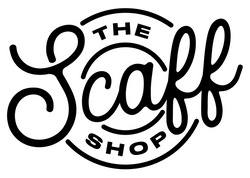With floating shelves being a favourite for home DIY’ers and a big seller for The Scaff Shop, we wanted to offer tips and tricks on installing your scaffold board wooden shelf. Floating shelves are an excellent alternative for those looking for a minimalist look rather than our custom Scaff Shop brackets. First off, when installing a floating shelf, it’s essential to make sure you have the correct tools for the job at hand. Nothing is worse than installing your floating shelf without a
level, as it will significantly affect how it will look when installed.
Jack, the founder of The Scaff Shop, has compiled a list of his essential tools to help make that Scaff Shop scaffold board floating shelf look as good as possible.
What tools would help with the installation?
● Stud finder
● Rawl plugs
● Screws
● Handheld electric drill
● Screwdriver
● Level
● Tape measure
● Pencil
Once you have your tools, you are ready to start the installation. We have broken this down into five steps.
Steps to putting up your Scaffold Board Floating Shelf
1. Preparation: Determine your wall type (drywall, plaster, etc.) to choose the appropriate hardware. Use a stud finder to locate wall studs for the most supportive base. If no studs are available, wall anchors will be necessary. The Scaff Shop provides plasterboard screws and wall plugs to cover the different wall types.
2. Marking the Placement: Decide the position on the wall where you want your floating shelf to hang, and mark the midpoint with a small pencil mark. Use a tape measure and level to mark the wall accurately using the midpoint small pencil mark as guidance. This ensures the shelf will be perfectly horizontal.
3. Installing the Bracket: Drill pilot holes at the marked spots for the anchors. If attaching directly to studs, anchors are not needed. For drywall or plaster, insert the chosen wall anchors into these holes. Secure the bracket to the wall with screws, making sure it's level.
4. Attaching the Shelf: Insert the floating rods into the back of the floating shelf. Ensure it's secure and make any necessary adjustments to align it properly.
5. Ready: Once the shelf is installed, you can decorate it with your chosen items,
considering its weight capacity and the wall it's attached to.
Additional Tips:
● For multiple shelves, ensure adequate spacing between them based on what you intend to place on them. We recommend spacing the floating shelves 11 to 17 inches apart for visual flow and to give items on the shelves adequate space.
● We recommend replacing the rawl plugs with wall anchors if you want to add over 35kg to your self-weight.

Here are some FAQ's on Floating Shelves that we have been asked so far:
In what rooms can you add rustic wooden shelves?
We have sold thousands of our reclaimed floating wooden shelves to customers over the years, and they have installed them all over their homes. Our reclaimed floating shelves offer a rustic look that can look good in kitchens, and we have seen so many customers create these shelves for cooking pots and recipe books. One of our favourites is a rustic shelf coffee station with beans, syrups and cups. The obvious choice for many is the front room or lounge for ornaments and books that have become quite the focal point. The Scaff Shop has seen an increase in
wooden floating shelves for the bathroom in 2024 as people look to freshen up their space.
What are floating shelves made from?
All our floating wooden shelves are made from wood, either new scaffold boards or reclaimed scaffold boards, which give them a rustic look. We prefer natural wood to manufactured wood or veneer style, which doesn’t offer the same quality, feel or timeless look. Scaffold board floating shelves provide a natural look and feel, and with our options, you can even choose an unsanded or sanded wood with various finishes. Remember, manufactured woods require a lot of processing even before the outer layer is added, and they can require chemicals and adhesives that natural woods don’t need. The rods are made from metal, allowing the shelves to hold considerable weight (35kg).

Why choose floating shelves?
Unlike bracket shelves, floating wooden shelves don’t have any hardware on display, providing a cleaner look than traditional hanging brackets being on display. Floating wooden shelves suit traditional and contemporary looks, making them quite flexible regarding room design.
How difficult are floating shelves to install?
Installing floating shelves can initially seem daunting for the novice DIYer, and many people will tell you they are difficult to do. Still, if you follow our simple guide, they are relatively simple. It is all about preparation and taking the time to find and ensure you have measured again. Any good tradesman's advice would be to measure twice! Think about what you would like on your floating wooden shelves, then use the correct fixings. Our boards and metal rods can hold a considerable amount of weight. The weakest point will be the wall fixings.
How much weight can a floating shelf hold?
The metal brackets we use can hold over 50kg in our tests; however, the wall fixings will be the weakest point. Suppose you are looking to hold heavier items like a selection of large heavy books. In that case, we suggest locating the wall noggins and attaching the fixings to the shelf, primarily on the plasterboard. For brick or stone walls, masonry fixings can hold more weight. For example, our 4ft boards and under have two floating shelf brackets that can be attached to all wall types. As mentioned above, our board and metal rods can hold considerable weight, so
try using a hollow wall anchor or a heavy-duty anchor for maximum strength.

